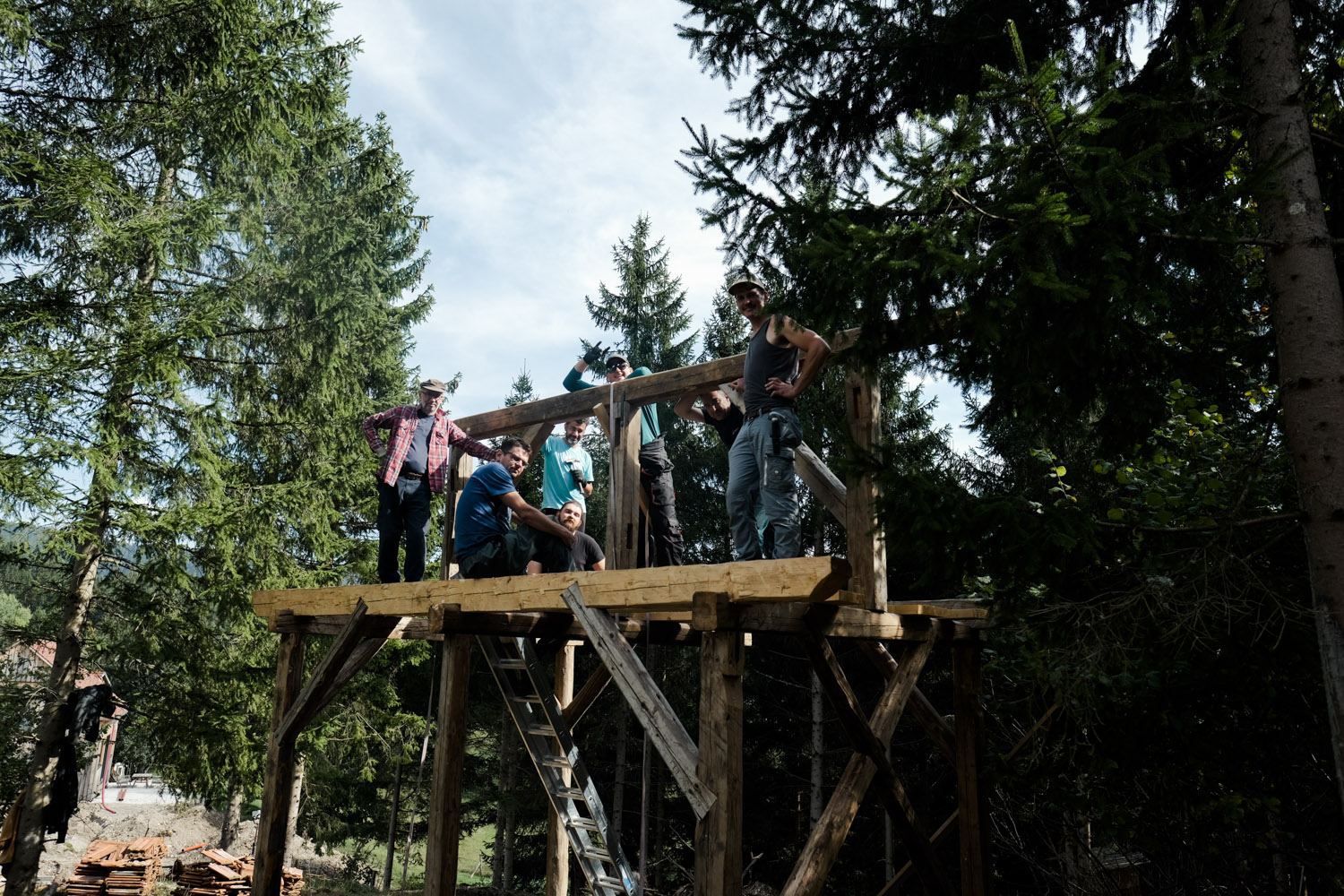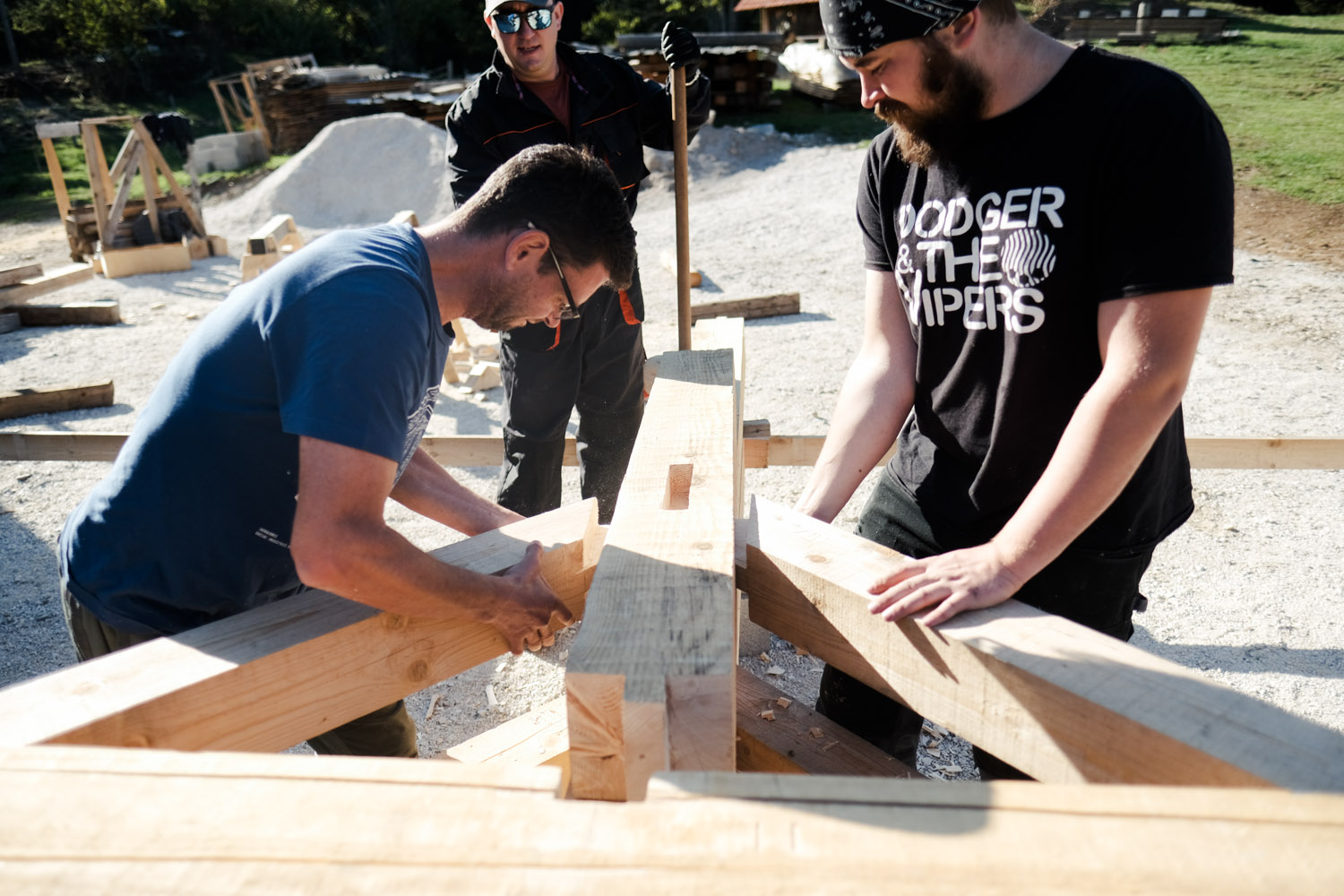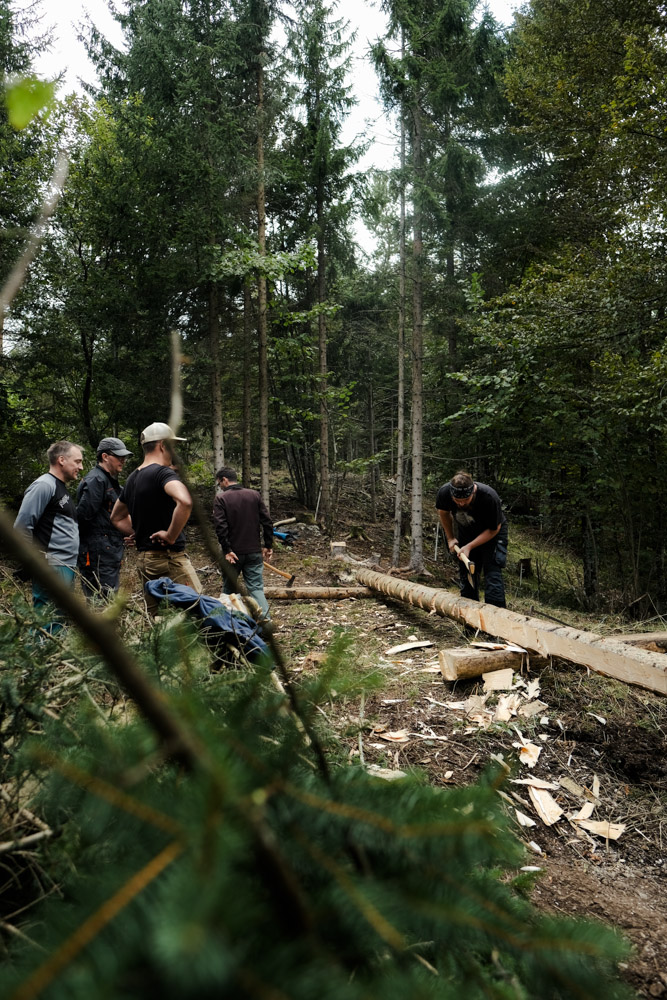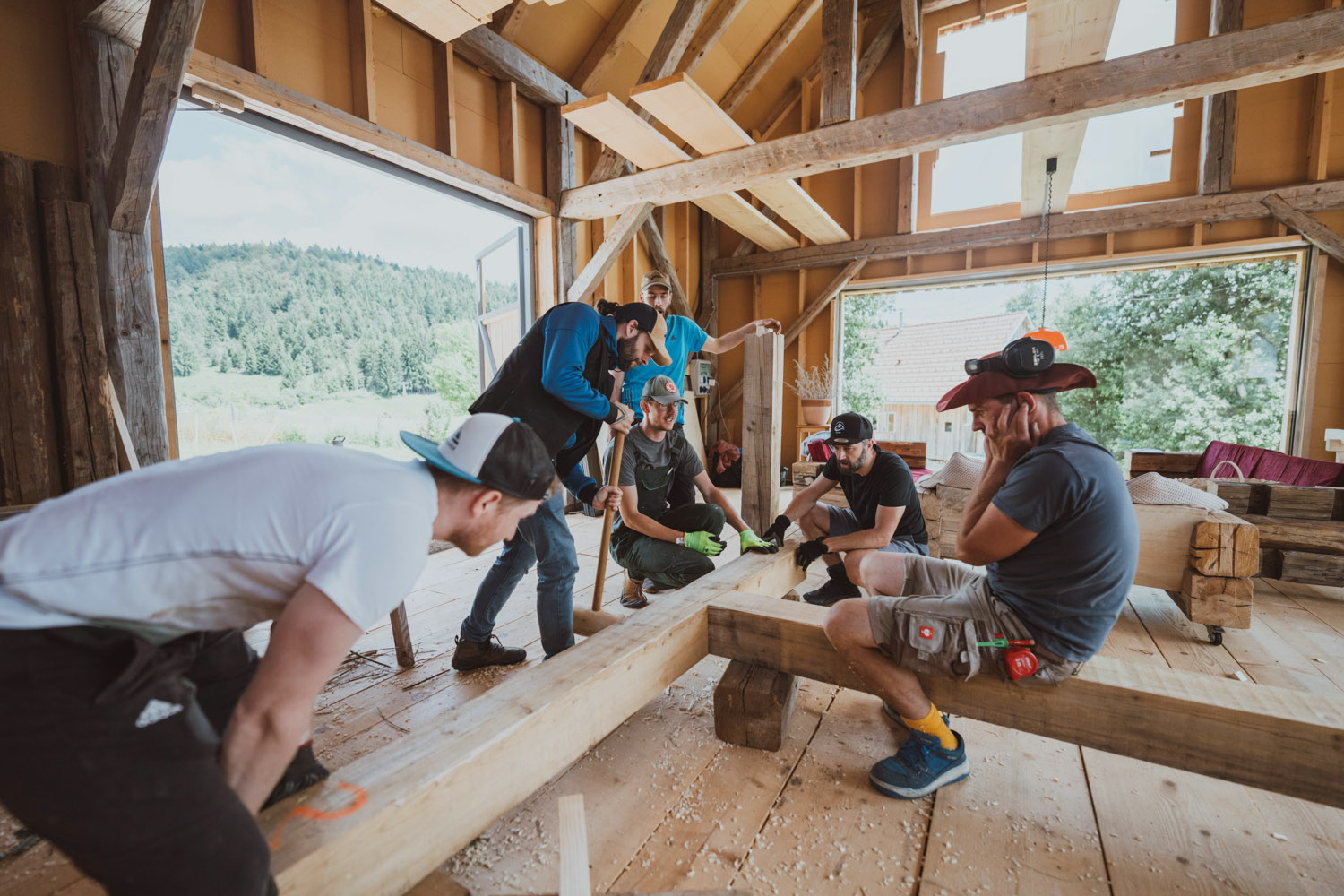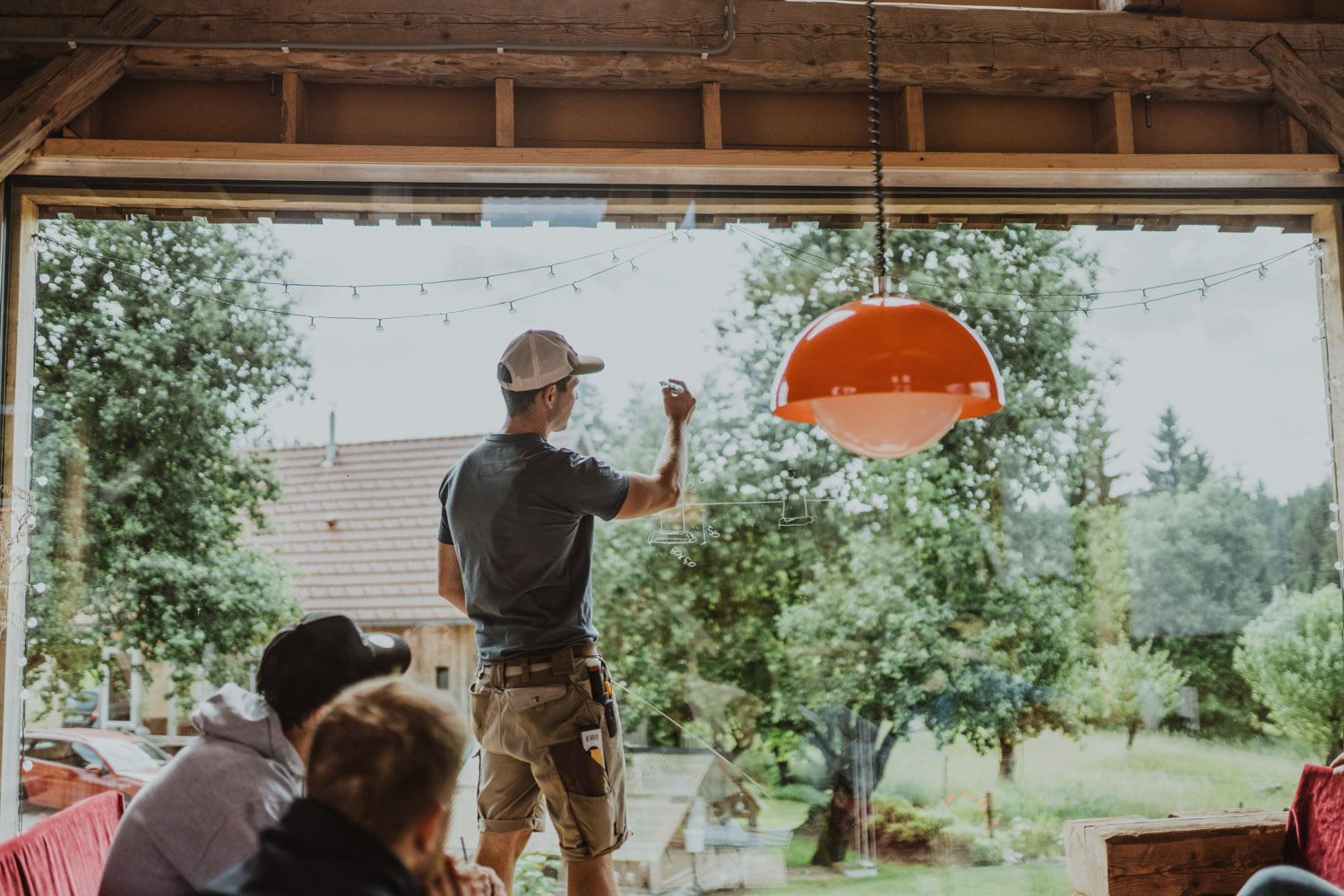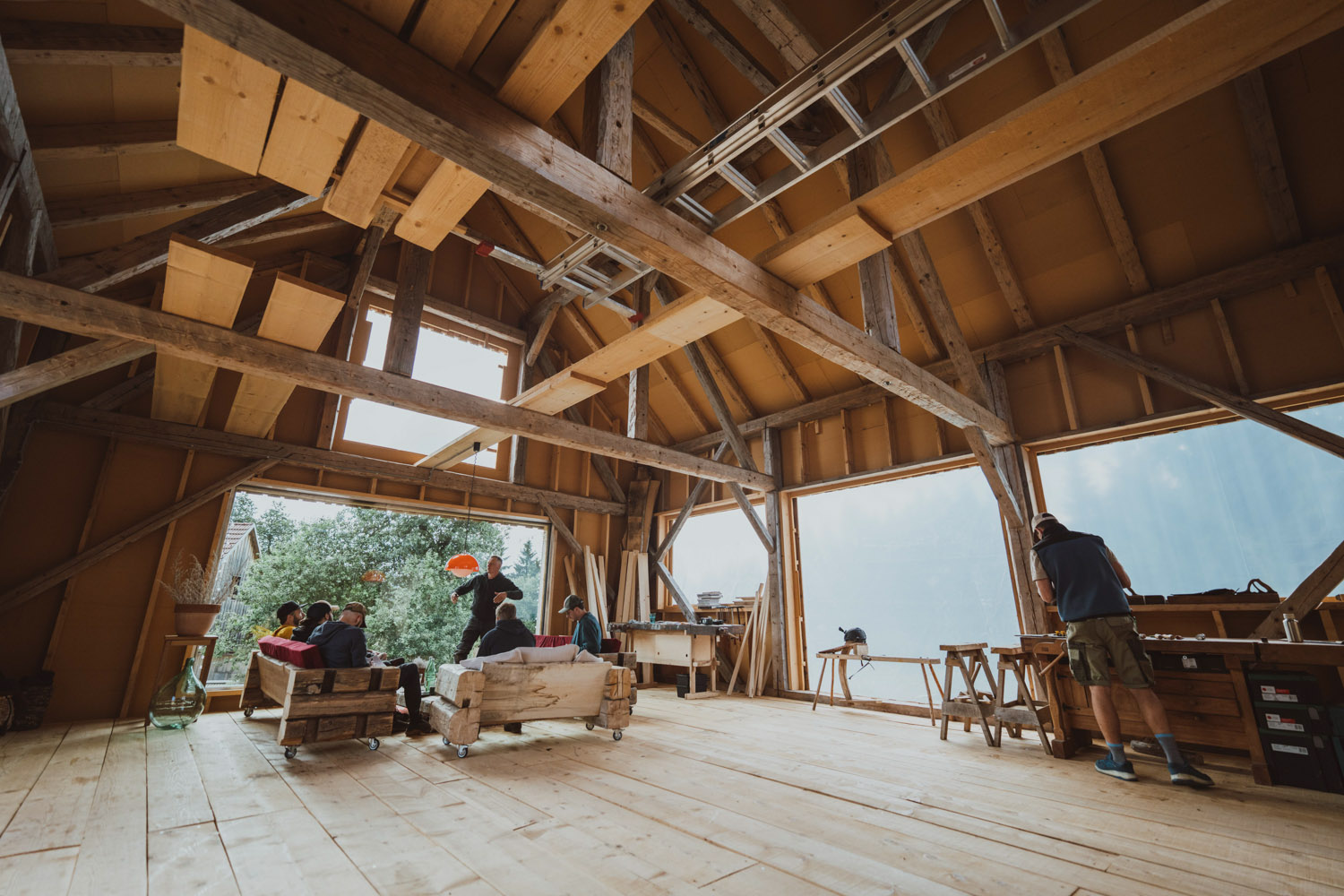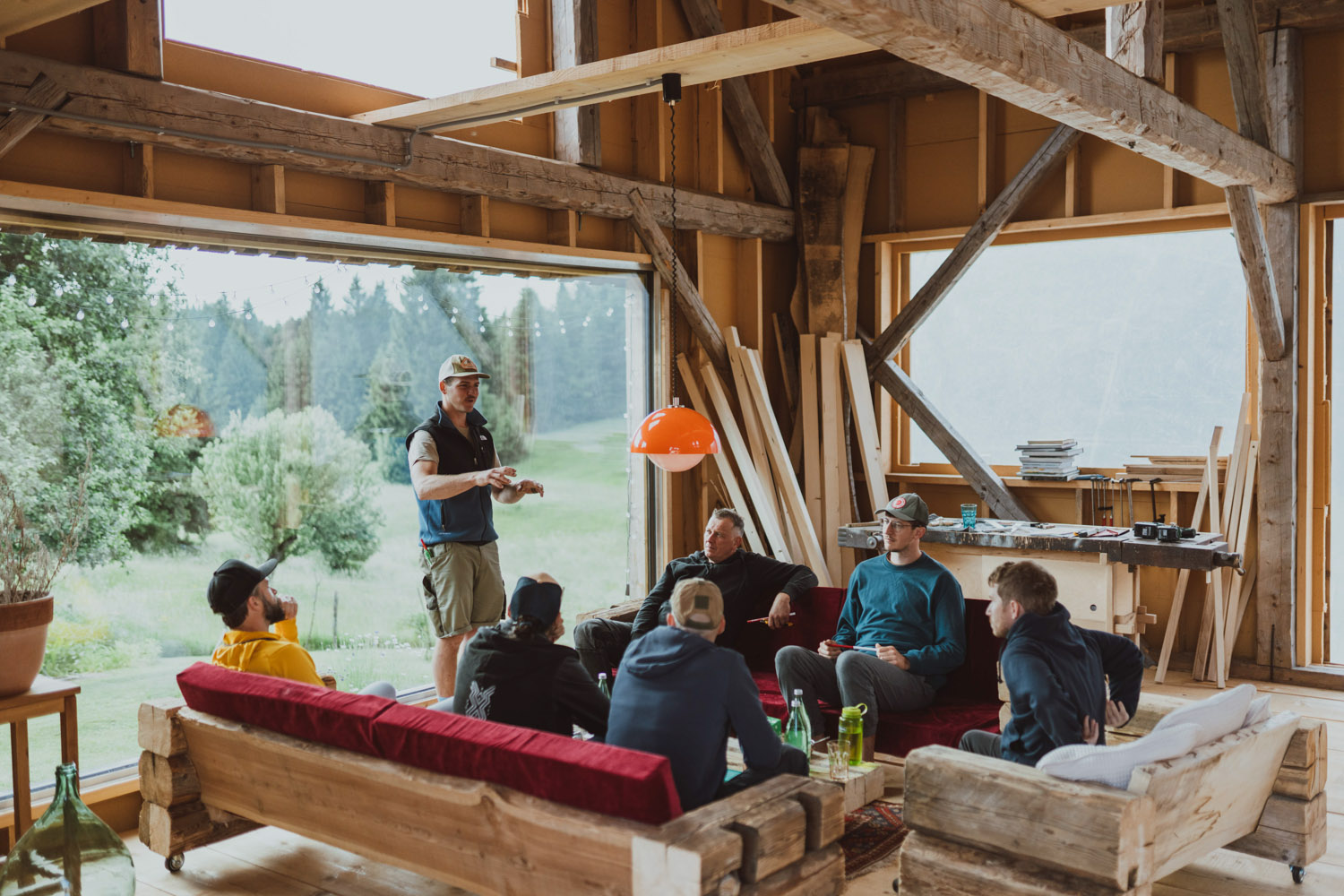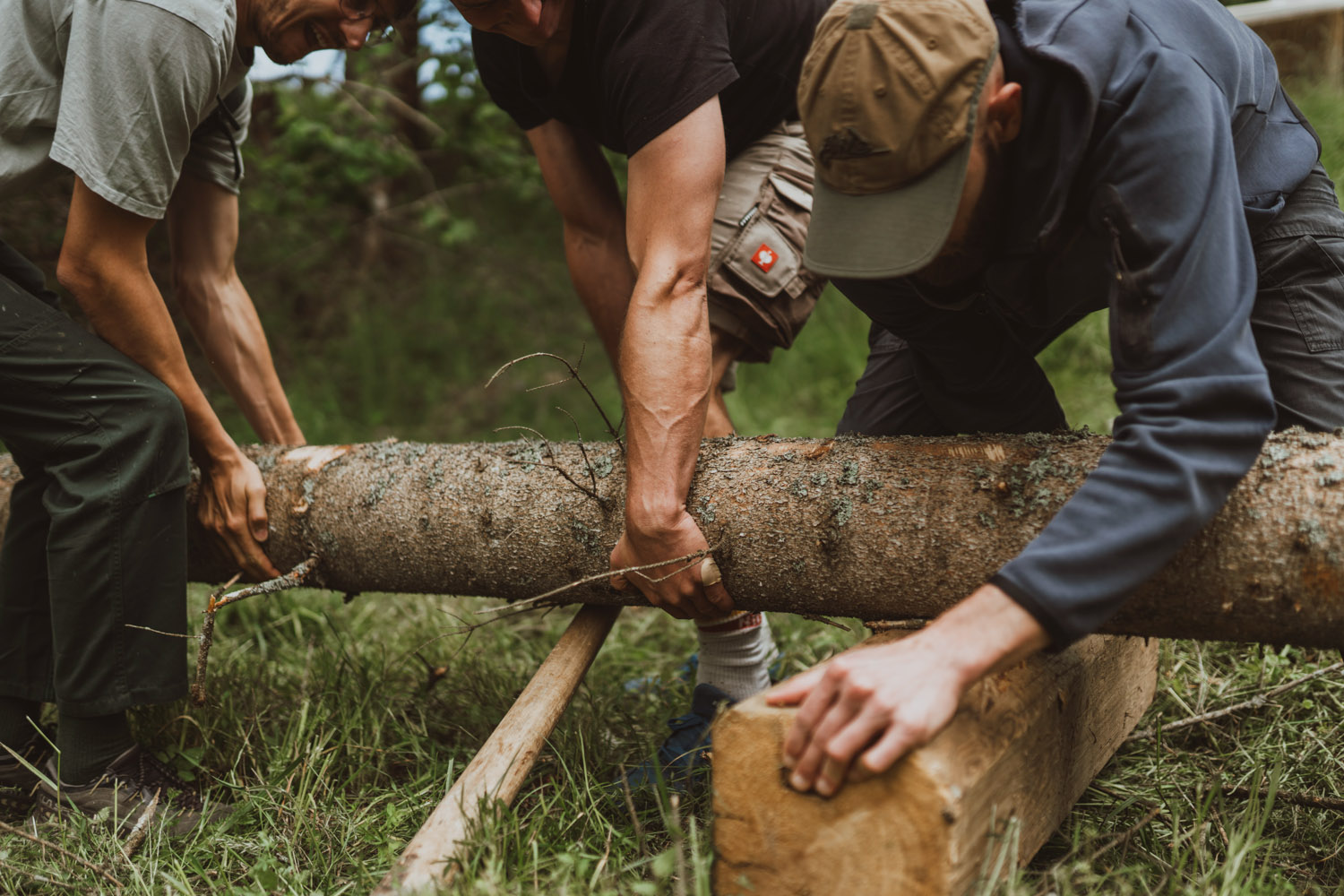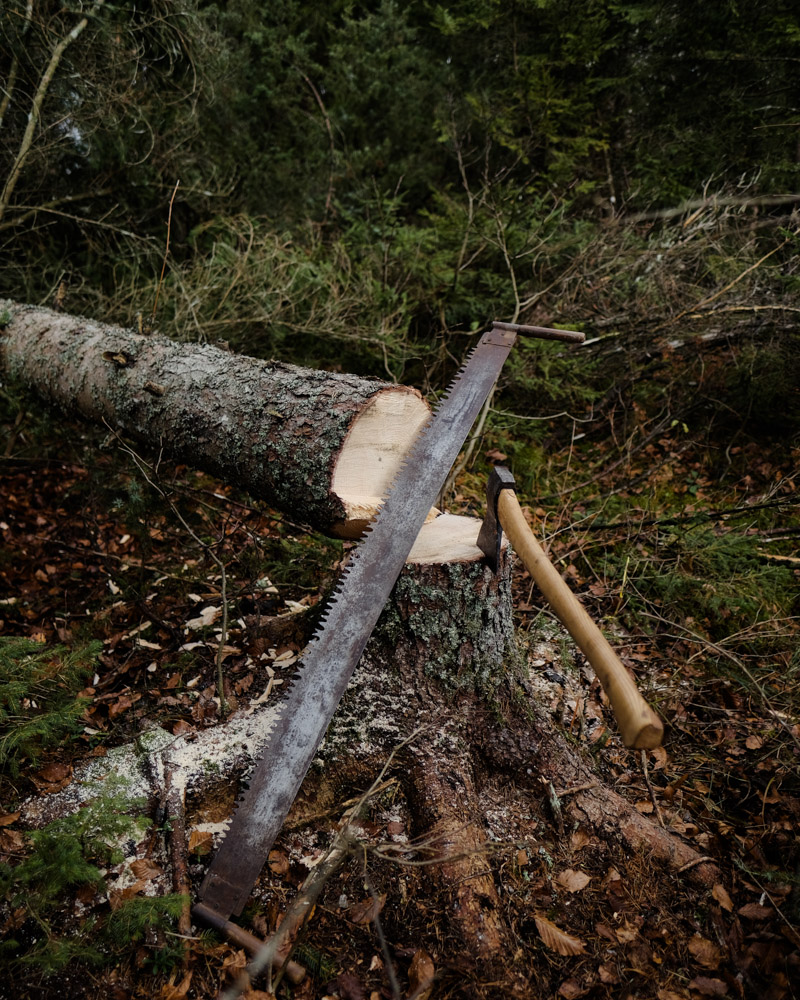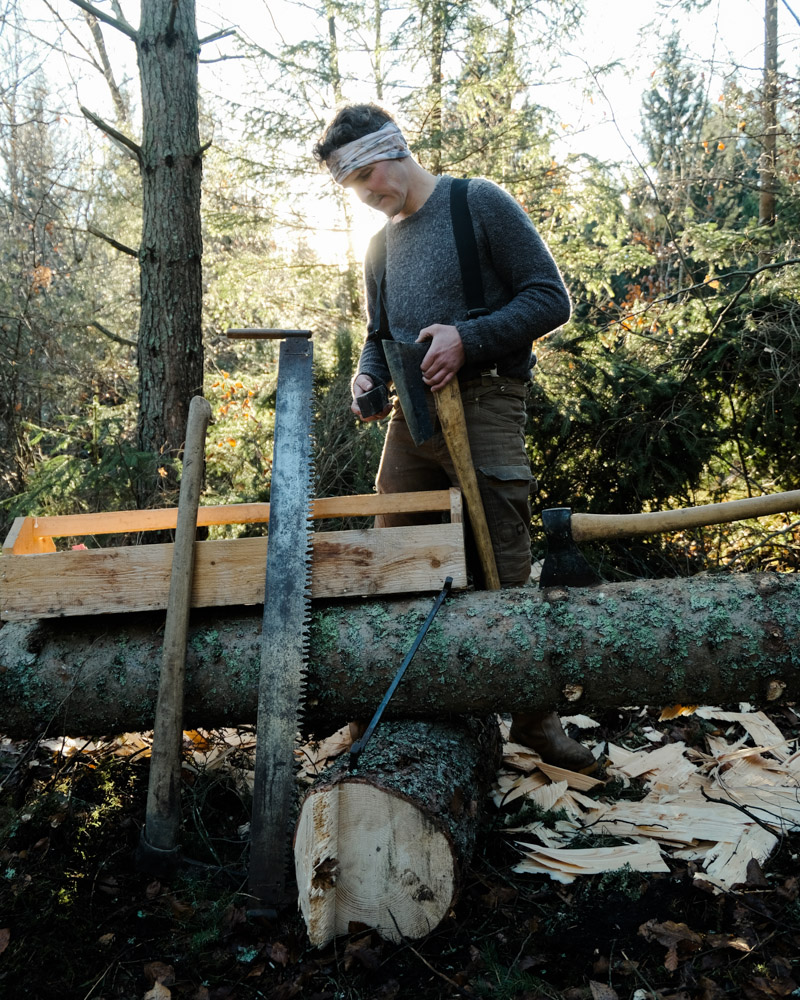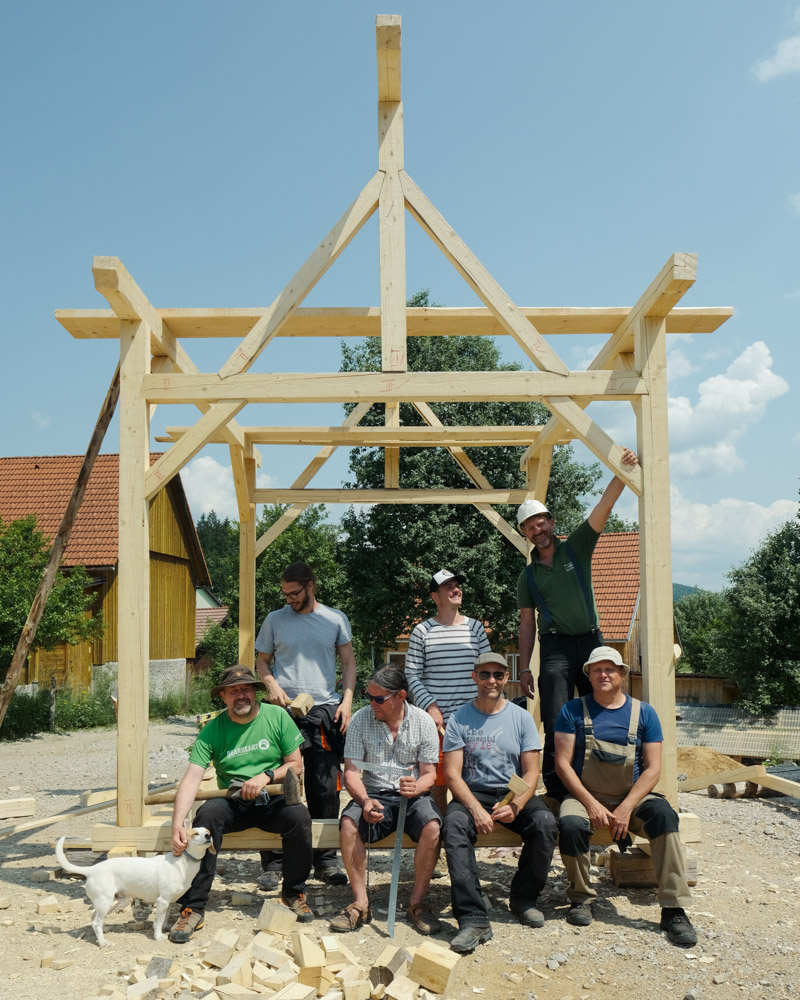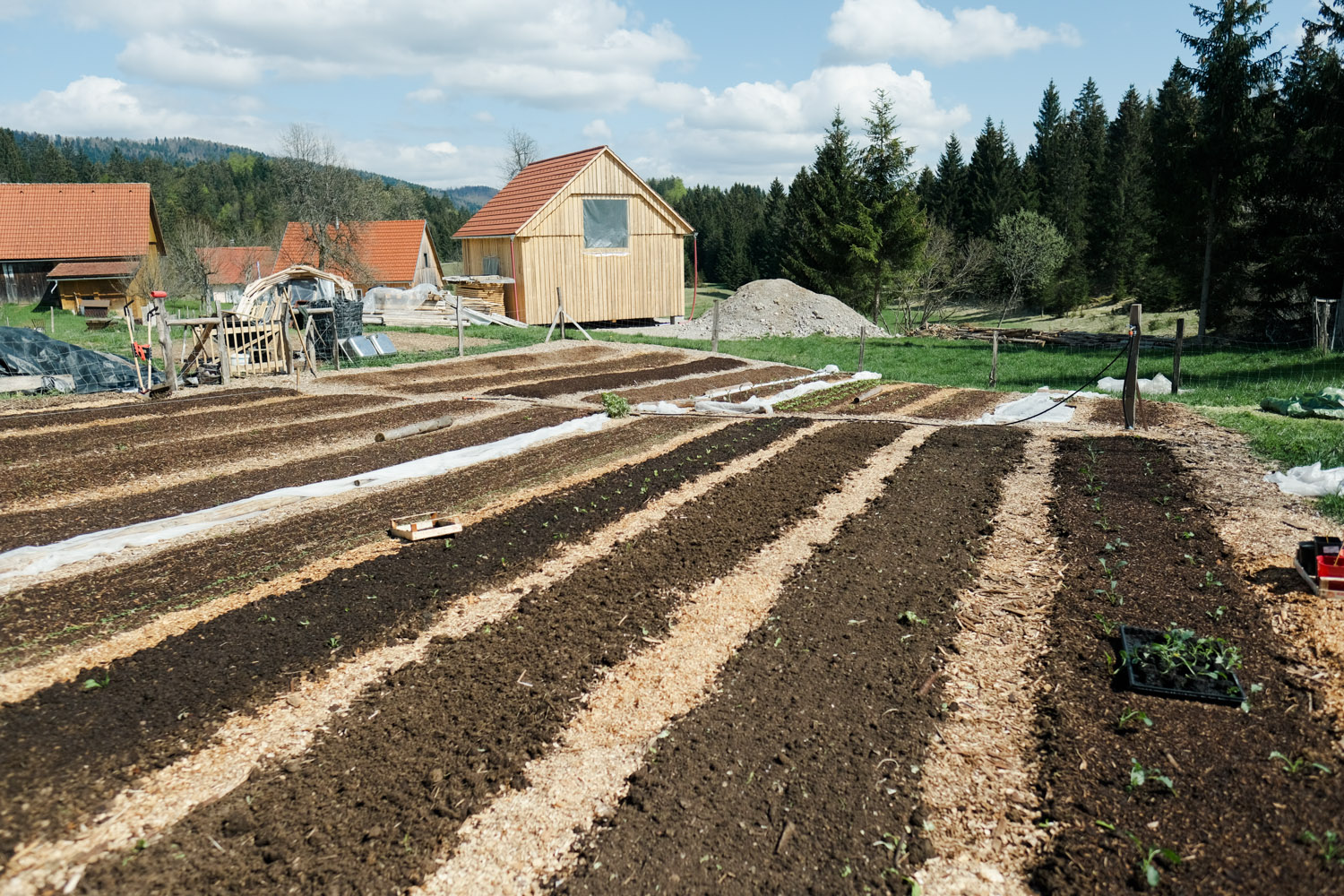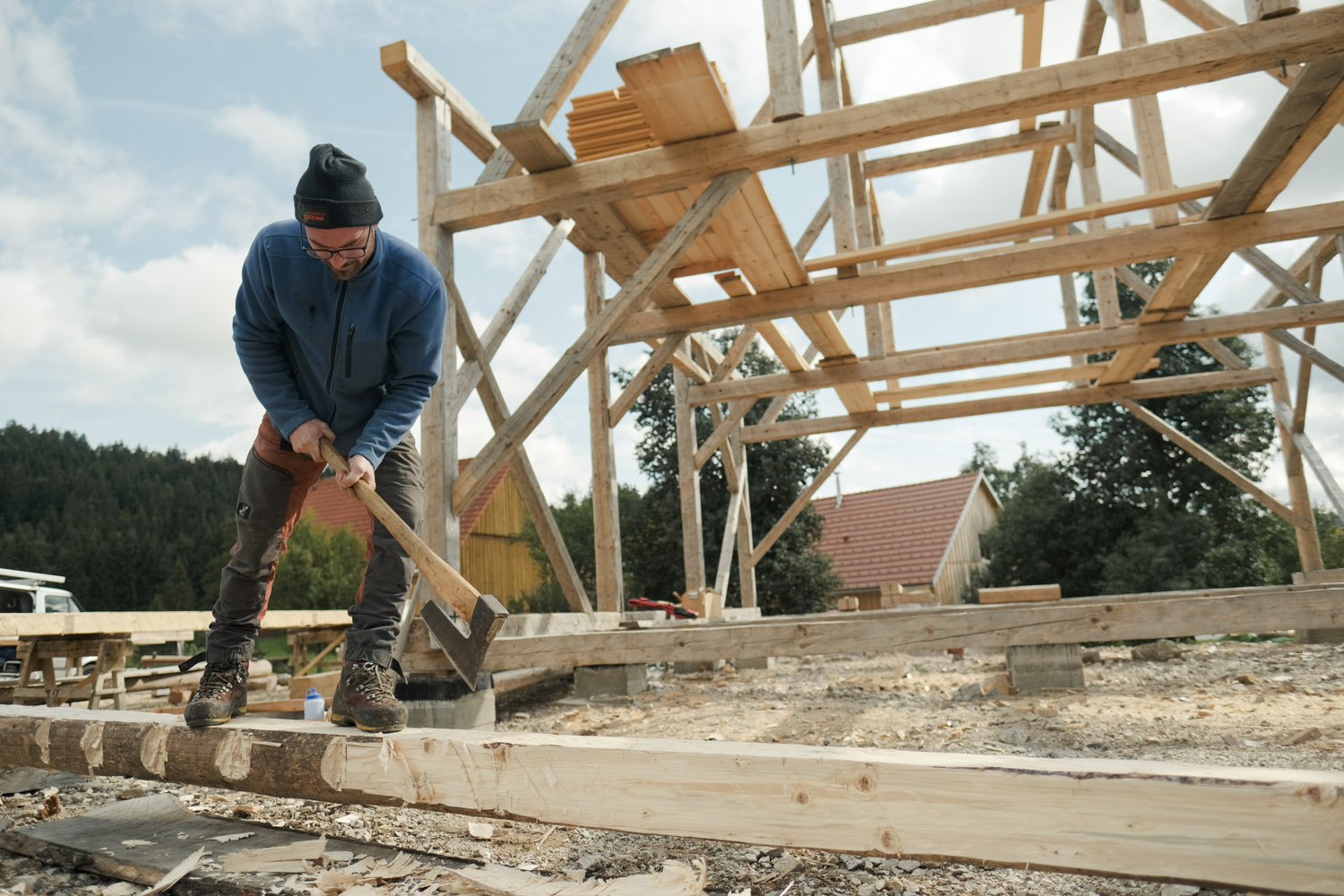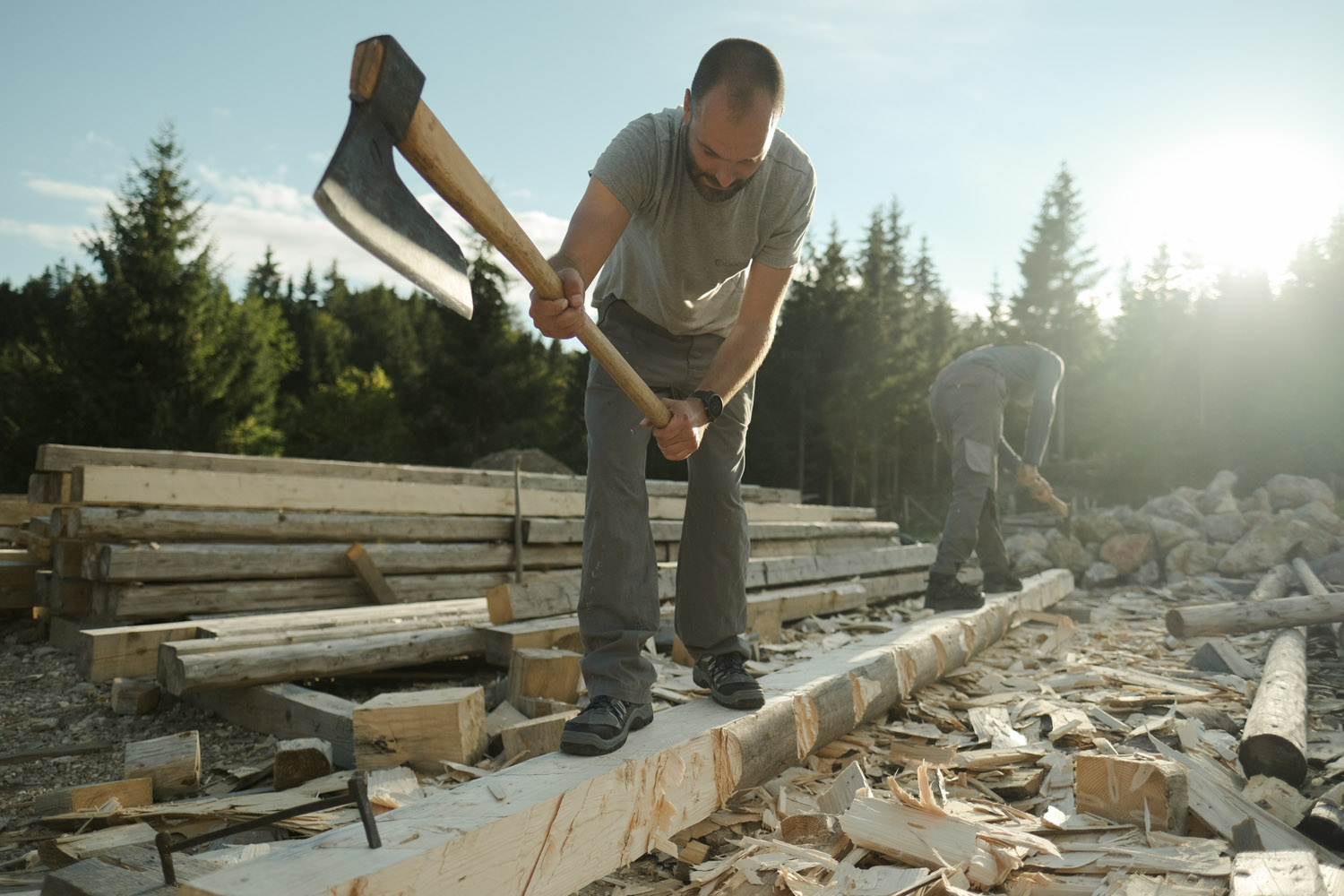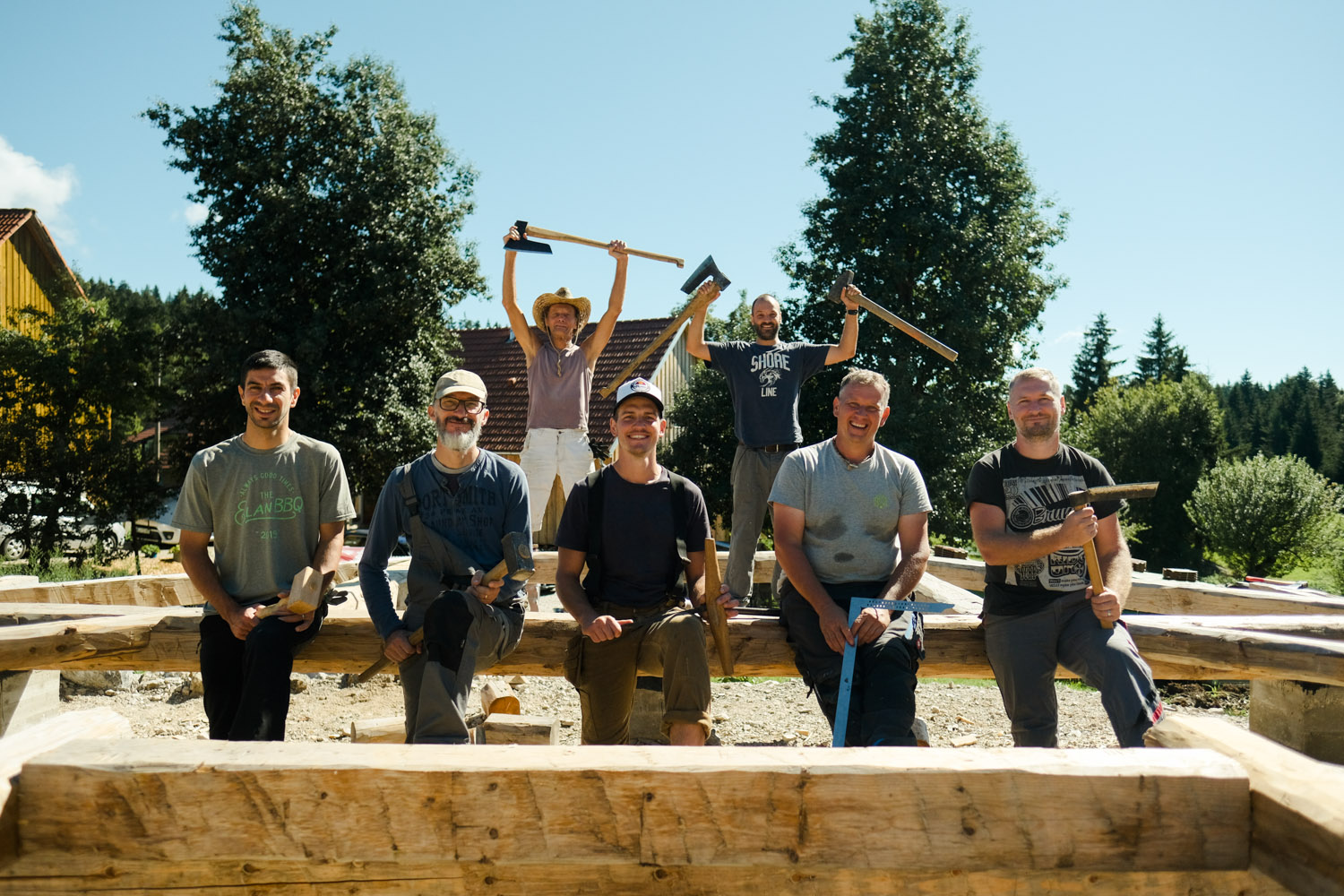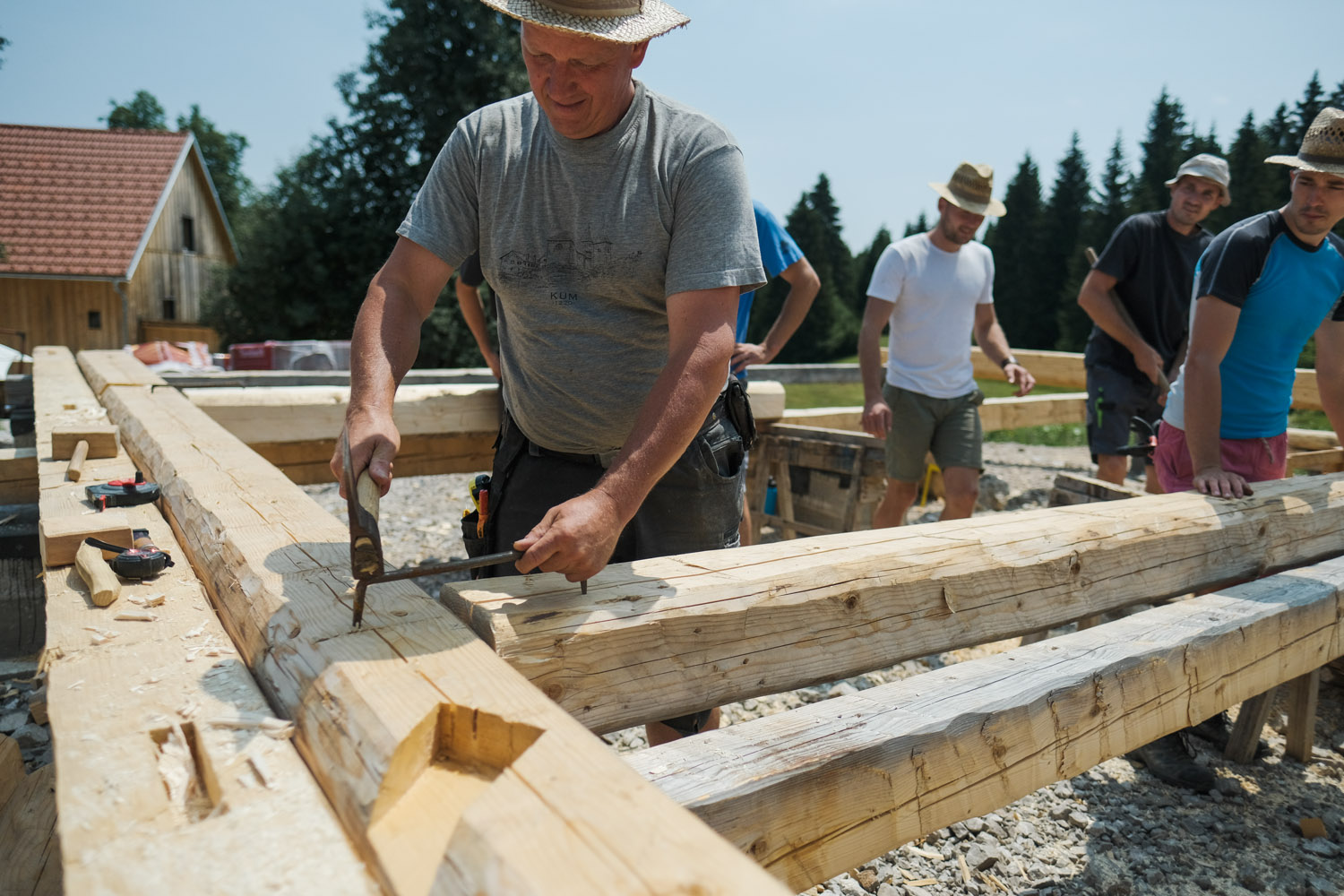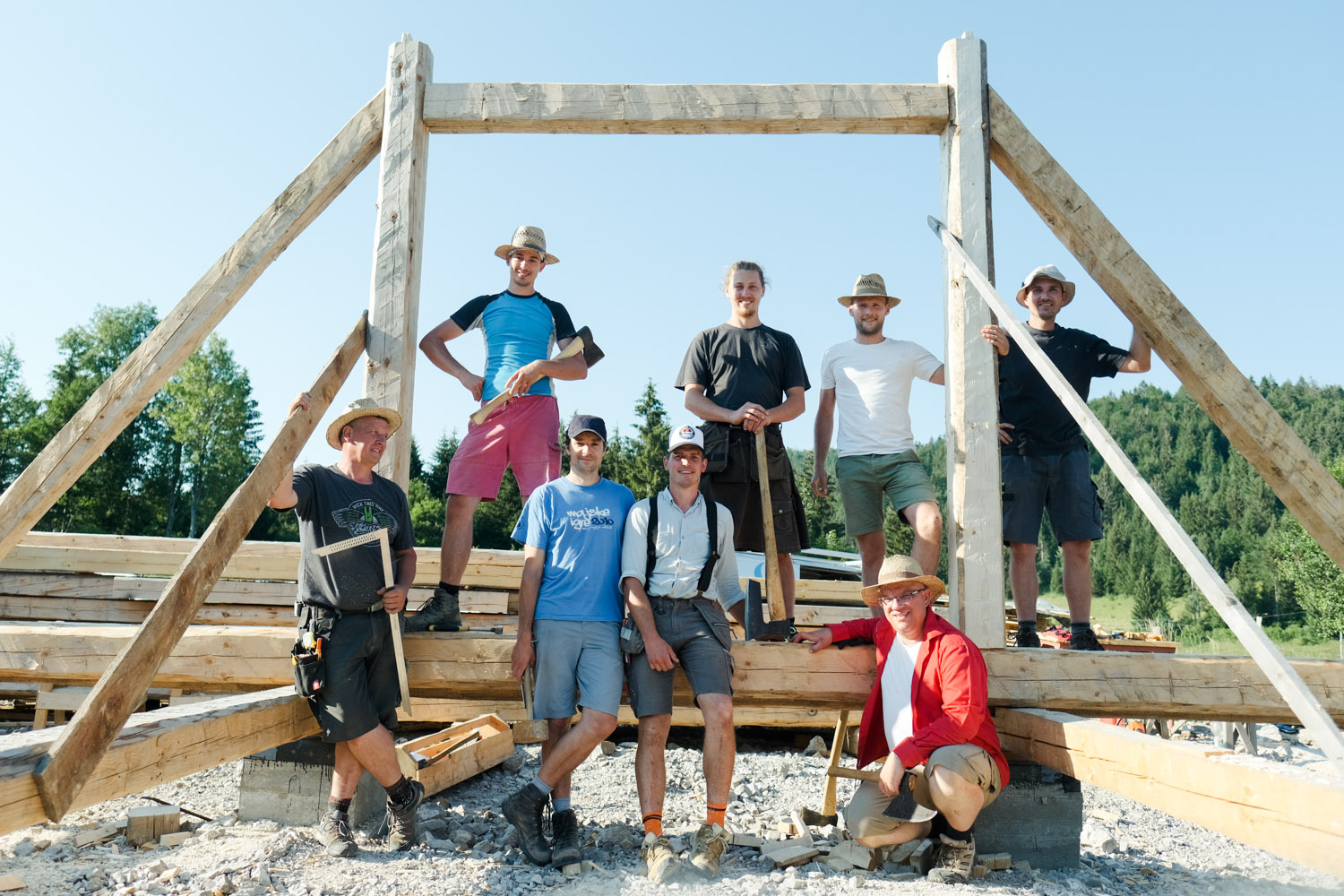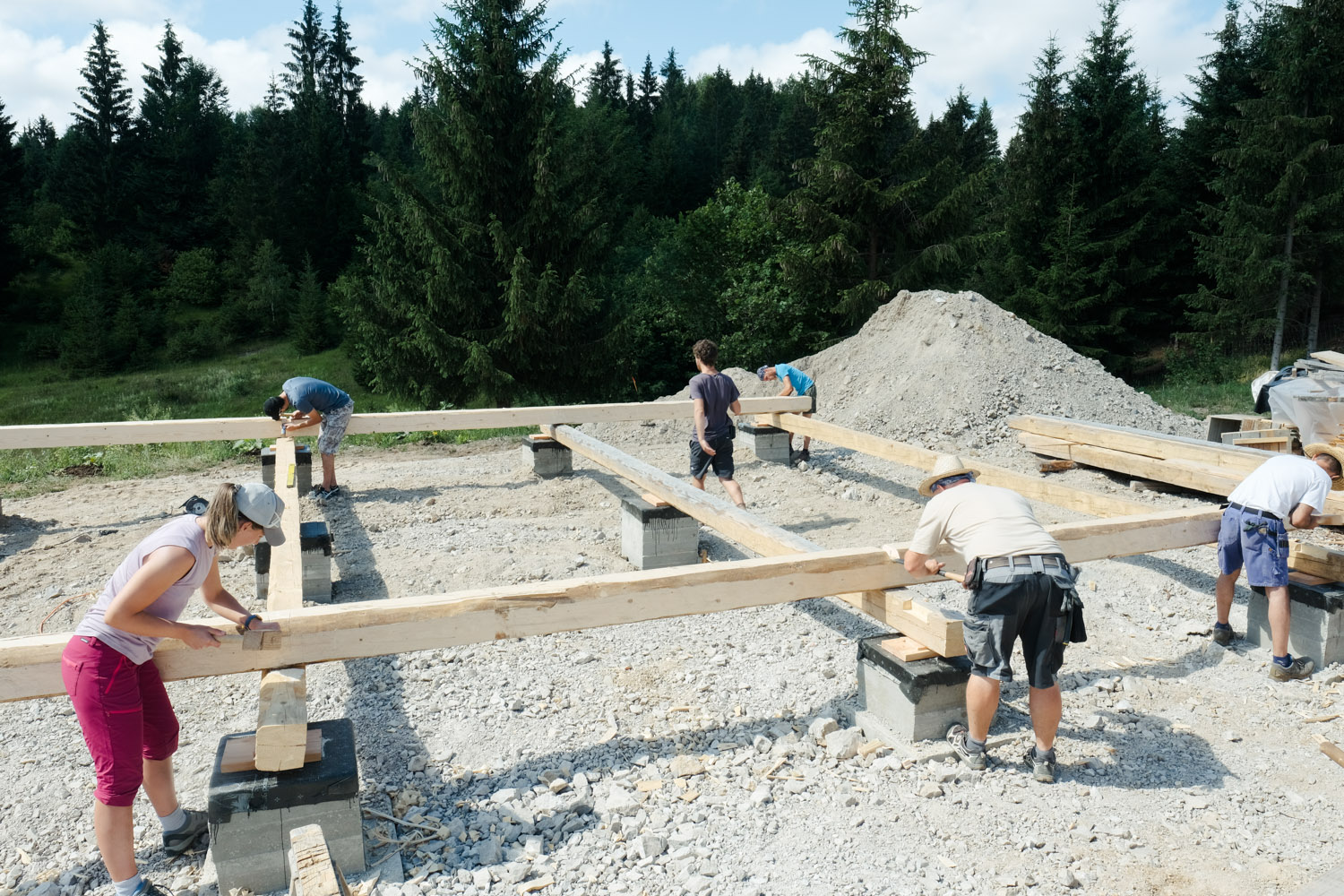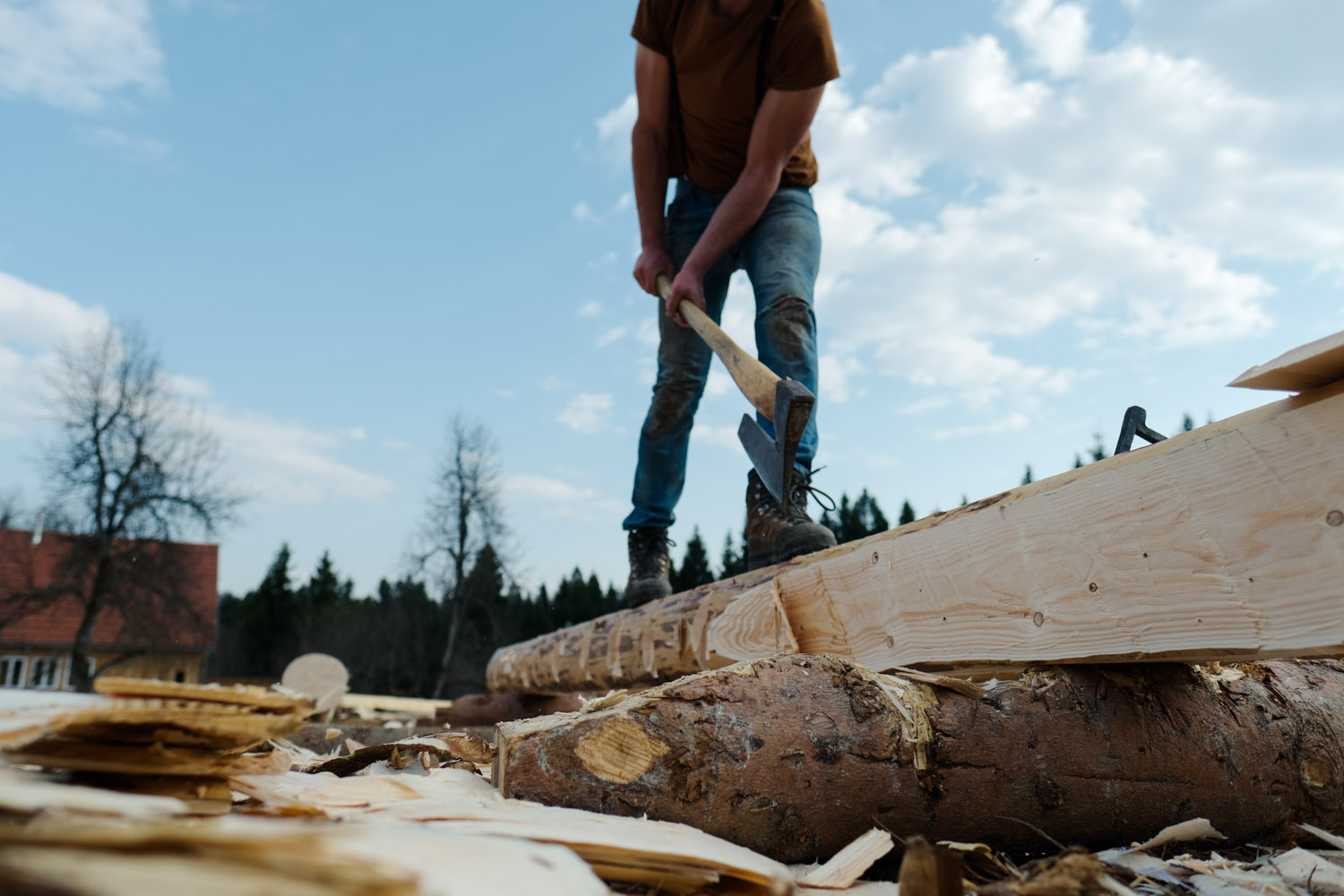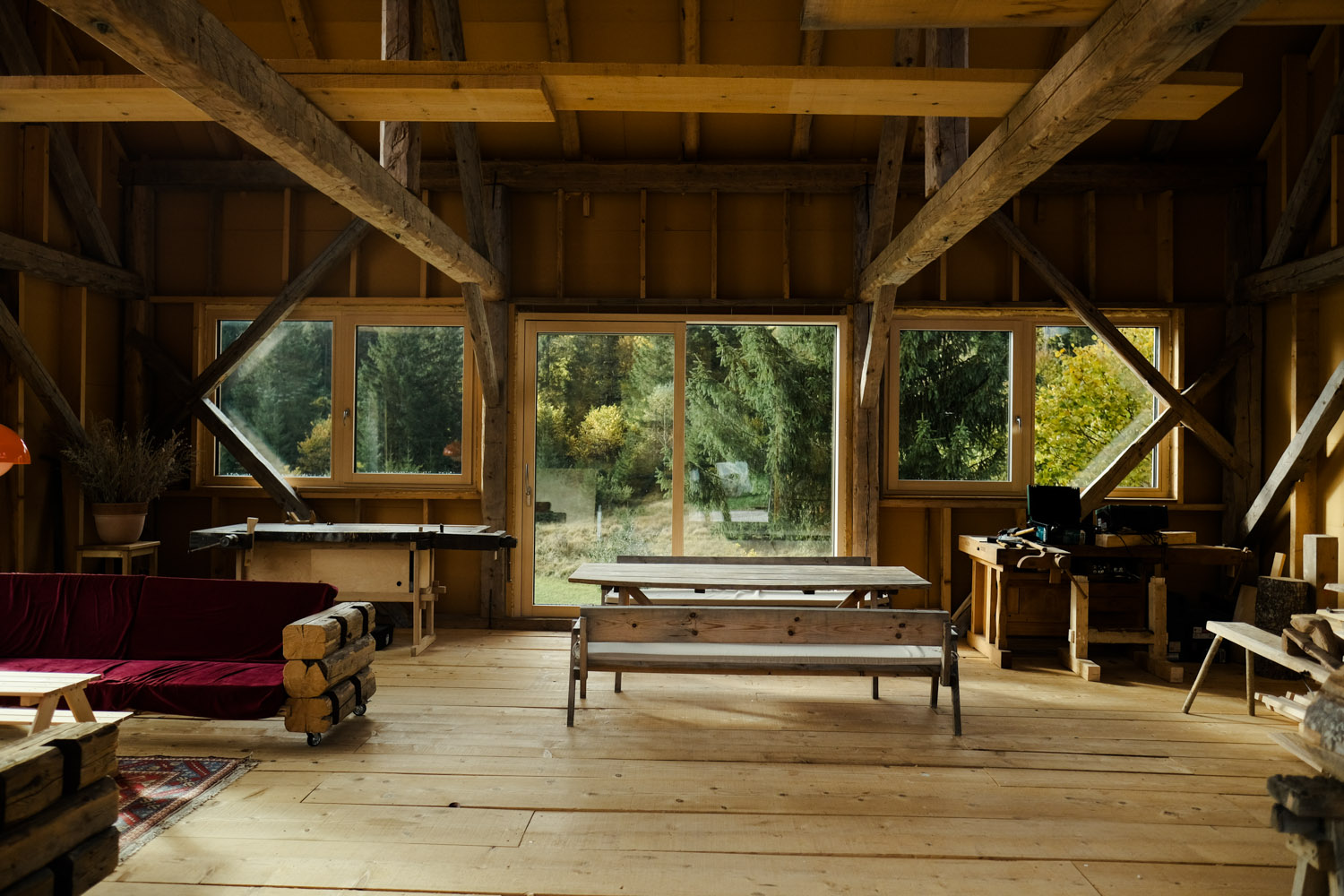Regaining a sense of belonging
Hiša Mandrova
Hiša Mandrova: Cultivating belonging through craftmanship
Hiša Mandrova is a grass root initiative led by local craftsmen to revive and pass on nearly forgotten skills of traditional carpentry: hand hewing and timber frame construction - a preindustrial crafts typical for the forest-covered border region of Loški Potok, SW Slovenia.
The project engages its community members through unique, inspiring creative workshops, that foster human connections, nurture craftsmanship, and spark positive change in the world.
The project engages its community members through unique, inspiring creative workshops, that foster human connections, nurture craftsmanship, and spark positive change in the world.
Slovenia
Local
Novi Kot, Loški Potok municipality
Mainly rural
It refers to a physical transformation of the built environment (hard investment)
Yes
2024-12-31
Yes
ERDF : European Regional Development Fund
No
Yes
Yes
Yes
As an individual partnership with other persons/organisation(s)
Hiša Mandrova strengthens the local creative community by reviving traditional woodworking skills, celebrating heritage crafts, and promoting the sustainable use of natural materials. Through unique, inspiring creative workshops, we foster human connections, nurture craftsmanship, and spark positive change in the world.
Hiša Mandrova began as a grass-roots initiative by young local artists and craftsmen Eva and Aljaž. In 2019 they relocated to one of the most remote forested plateaus in SW Slovenia. In the past, this remote border region of Loški Potok was subjected to negative demographic trends (aging and depopulation). Thus the local crafts and traditions were nearly forgotten, due to the lack of interest, lack of proper documentation, and economic decline of the border region.
The main objective of Hiša Mandrova was to systematically preserve, revive, and document the nearly forgotten crafts of hand hewing and timber construction and pass the knowledge to the participants of our unique workshops. The secondary objective of the project is the revitalization of the underdeveloped region through the implementation of a sustainable form of creative tourism.
Through the involvement of the local community, master craftsmen, and international workshop participants in only 4 years Hiša Mandrova became a widely recognized venue for learning new skills, promoting a sustainable lifestyle and regaining a sense of touch with the beauty and simplicity of woodworking.
The most significant undertaking of the project is the building of a new, hand-hewn workshop building. The first hand-hewn timber frame construction after nearly 70 years, was built with the help of workshop participants. In 2024 the building received a Slovenia - arts & crafts certificate.
In less than 4 seasons of running workshops, we hosted nearly 500 participants, who later managed to apply the woodworking skills to make their own buildings. In addition to that, we hosted numerous education groups.
Hiša Mandrova began as a grass-roots initiative by young local artists and craftsmen Eva and Aljaž. In 2019 they relocated to one of the most remote forested plateaus in SW Slovenia. In the past, this remote border region of Loški Potok was subjected to negative demographic trends (aging and depopulation). Thus the local crafts and traditions were nearly forgotten, due to the lack of interest, lack of proper documentation, and economic decline of the border region.
The main objective of Hiša Mandrova was to systematically preserve, revive, and document the nearly forgotten crafts of hand hewing and timber construction and pass the knowledge to the participants of our unique workshops. The secondary objective of the project is the revitalization of the underdeveloped region through the implementation of a sustainable form of creative tourism.
Through the involvement of the local community, master craftsmen, and international workshop participants in only 4 years Hiša Mandrova became a widely recognized venue for learning new skills, promoting a sustainable lifestyle and regaining a sense of touch with the beauty and simplicity of woodworking.
The most significant undertaking of the project is the building of a new, hand-hewn workshop building. The first hand-hewn timber frame construction after nearly 70 years, was built with the help of workshop participants. In 2024 the building received a Slovenia - arts & crafts certificate.
In less than 4 seasons of running workshops, we hosted nearly 500 participants, who later managed to apply the woodworking skills to make their own buildings. In addition to that, we hosted numerous education groups.
Heriatage preservation
Sustainable craftsmanship
Traditional carpentry
Rural revitalisation
Experiential learning
Hiša Mandrova is committed to sustainability through the revival of local crafts, hyper-local use of materials and education on sustainable use of natural resources.
Our project celebrates low-impact woodworking traditions over energy-intensive industrial practices. Our aim is to demonstrate how traditional knowledge can address modern sustainability challenges by reducing emissions and showcasing how it is more than just viable to make things with hand tools. We believe that the future belongs to the artisans of sustainable crafts.
Through our own example we are setting an example how local use of timber is the alternative to the globalized supply of conventional building materials. The wood we are using comes from surrounding sustainably managed forests. At the remote forest plateau where Hiša Mandorva is located, timber is historically the most significant natural material. The mission we are on is adding value to the timber, crafting it into beautiful, carbon negative wooden constructions and products. Most of the materials we use are sourced less than 5km from our location.
The nature of our project is educational. We are organizing workshops and hosting groups. For that we are using a framework of sustainable creative tourism model, with low environmental impact. Our accommodations are built with local wood, at Hiša Mandrova we grow most of the produce that we serve to our visitors. The rest of produce comes from organic certified local growers. We always encourage our visitors to share a ride to our remote location.
With this comprehensive sustainable approach, we want to showcase that a modern, creative lifestyle can be combined with natural building techniques and ecological farming. Our project is focusing on raising awareness of the role of forests in global ecology and the meaning of sustainable forest management and ecological lifestyle. We aim to be an example where people can learn about the alternatives for sustainable living.
Our project celebrates low-impact woodworking traditions over energy-intensive industrial practices. Our aim is to demonstrate how traditional knowledge can address modern sustainability challenges by reducing emissions and showcasing how it is more than just viable to make things with hand tools. We believe that the future belongs to the artisans of sustainable crafts.
Through our own example we are setting an example how local use of timber is the alternative to the globalized supply of conventional building materials. The wood we are using comes from surrounding sustainably managed forests. At the remote forest plateau where Hiša Mandorva is located, timber is historically the most significant natural material. The mission we are on is adding value to the timber, crafting it into beautiful, carbon negative wooden constructions and products. Most of the materials we use are sourced less than 5km from our location.
The nature of our project is educational. We are organizing workshops and hosting groups. For that we are using a framework of sustainable creative tourism model, with low environmental impact. Our accommodations are built with local wood, at Hiša Mandrova we grow most of the produce that we serve to our visitors. The rest of produce comes from organic certified local growers. We always encourage our visitors to share a ride to our remote location.
With this comprehensive sustainable approach, we want to showcase that a modern, creative lifestyle can be combined with natural building techniques and ecological farming. Our project is focusing on raising awareness of the role of forests in global ecology and the meaning of sustainable forest management and ecological lifestyle. We aim to be an example where people can learn about the alternatives for sustainable living.
The project showcases how the simplicity of traditional crafts and architecture can meets the needs of modern life. Hiša Mandrova was born out of respect to the vernacular aesthetic qualities of local architecture and the landscape, merging it with the sustainable designs of our buildings. Through our own example we are promoting the value of traditional wooden architecture and offer workshop participants a chance to embrace, enjoy and learn how they can build in a similar matter.
We recognized the need of locals and urban visitors to cultivate a sense of belonging to the space through learning of new skills. That is why we are organizing unique workshops where participants learn traditional carpentry skills of hand hewing and timber framing. We are creating a learning experience that often pushes people out of their comfort zone and this has a deep transformative effect on the life of an individual.
Our workshops are places where we nurture a genuine human connection, battling the “loneliness epidemic”, caused by immersive technologies and social media. At Hiša Mandrova traditional crafts bring people together in the spirit of companionship, genuine human connection and sharing of knowledge. We showcase how traditional woodworking, and crafts can be a catalyst of change, bringing people together and helping them develop a new countryside cultural identity.
We are especially proud that we built our new workshop building with the help of workshop participants, who participated in hand hewing of the beams and carpentry works. The build began in 2021 by sourcing the timber as close to the construction site as possible. The timber was hand hewn and the wood joinery made by master craftsman in collaboration with workshop participants. Our new building is the first hand made timber frame since the 2. WW. The architecture was inspired by local barns.
We recognized the need of locals and urban visitors to cultivate a sense of belonging to the space through learning of new skills. That is why we are organizing unique workshops where participants learn traditional carpentry skills of hand hewing and timber framing. We are creating a learning experience that often pushes people out of their comfort zone and this has a deep transformative effect on the life of an individual.
Our workshops are places where we nurture a genuine human connection, battling the “loneliness epidemic”, caused by immersive technologies and social media. At Hiša Mandrova traditional crafts bring people together in the spirit of companionship, genuine human connection and sharing of knowledge. We showcase how traditional woodworking, and crafts can be a catalyst of change, bringing people together and helping them develop a new countryside cultural identity.
We are especially proud that we built our new workshop building with the help of workshop participants, who participated in hand hewing of the beams and carpentry works. The build began in 2021 by sourcing the timber as close to the construction site as possible. The timber was hand hewn and the wood joinery made by master craftsman in collaboration with workshop participants. Our new building is the first hand made timber frame since the 2. WW. The architecture was inspired by local barns.
Hiša Mandrova is an inclusive, cross generation, community project, serving the needs of local population and international visitors. An important focus of our project is our efforts to preserve heritage through participation of visitors in the form of a single or multi day workshops. We are committed that our workshops can be accessed by everyone. Our tuition fees are affordable and cover the costs of materials, master craftsman fees and accommodation costs.
Aside from the workshops we are also available to the public free of charge. For that we organise open day events, up to 5 times per season. In less than 4 years we hosted 80 workshops with 492 participants and more than 20 free events with an equal number of visitors. In addition to that we are offering craft demonstrations to local and national school groups.
We promote the democratic nature and affordability of materials we work with - the wood. We want to inspire people to use more local materials than they do now. We believe the timber, main natural resource in Slovenia, should be accessed (and worked) by everyone, and learning how timber is worked into products is the entry point into the fair timber economy.
The participants of our workshops and opened days are inspired by the fact that they, for a short time almost became members of our team as they actively participate in the revival of the crafts, learning and designing of things we create together.
In this way every participant is empowered by the experience of Hiša Mandrova, because they are learning new skills that fulfills their life. This approach helped us to build a community of returning visitors.
Aside from the workshops we are also available to the public free of charge. For that we organise open day events, up to 5 times per season. In less than 4 years we hosted 80 workshops with 492 participants and more than 20 free events with an equal number of visitors. In addition to that we are offering craft demonstrations to local and national school groups.
We promote the democratic nature and affordability of materials we work with - the wood. We want to inspire people to use more local materials than they do now. We believe the timber, main natural resource in Slovenia, should be accessed (and worked) by everyone, and learning how timber is worked into products is the entry point into the fair timber economy.
The participants of our workshops and opened days are inspired by the fact that they, for a short time almost became members of our team as they actively participate in the revival of the crafts, learning and designing of things we create together.
In this way every participant is empowered by the experience of Hiša Mandrova, because they are learning new skills that fulfills their life. This approach helped us to build a community of returning visitors.
Our activities exemplify three core working principles of the New European Bauhaus
Sustainability: By using locally sourced, sustainably managed timber and eco-friendly construction techniques, we demonstrate that traditional craftsmanship can meet modern environmental standards.
Inclusion: our workshops and events are accessible and affordable for all,
ensuring that people from diverse backgrounds, age groups, and geographies can participate. By keeping tuition fees low and hosting free public events, we are removing financial and social barriers.
Aesthetics: Our project revitalizes local architectural styles and crafts, preserving the beauty of vernacular design while adapting it for modern use. This co-creation ensures that finished structures are both functional and inspirational, embodying the aesthetic values of the New European Bauhaus.
Sustainability: By using locally sourced, sustainably managed timber and eco-friendly construction techniques, we demonstrate that traditional craftsmanship can meet modern environmental standards.
Inclusion: our workshops and events are accessible and affordable for all,
ensuring that people from diverse backgrounds, age groups, and geographies can participate. By keeping tuition fees low and hosting free public events, we are removing financial and social barriers.
Aesthetics: Our project revitalizes local architectural styles and crafts, preserving the beauty of vernacular design while adapting it for modern use. This co-creation ensures that finished structures are both functional and inspirational, embodying the aesthetic values of the New European Bauhaus.
Hiša Mandrova first started as a grass root initiative, slowly gaining recognition and attention through heritage crafts revival efforts.
We were able to kick start the project's main educational activities with the help of the EU Regional Development fund grant under the scheme of Center for Creativity at Museum of Architecture and Design Ljubljana. The initial funds allowed us to develop, test and market the business idea for our workshop. Since then, we have been collaborating with the Center for Creativity as one of the best, exemplary projects, enhancing our visibility and credibility across Europe. Beyond funding, the Center for Creativity has provided a platform for networking and showcasing our work nationally, facilitating connections with other cultural and creative initiatives across Slovenia.
On a regional level, we have been closely collaborating with The Public Institute Ribnica Handicraft Centre and Regional Museum Kočevje, which provided guidelines for the project development and opportunities to present our work to the public. The partnership with these regional public institutions was key for the implementation of the project. They offered expertise in heritage crafts and provided opportunities to present our work to their audiences. Their support was crucial in refining our approach and reaching a broader regional audience.
On a local level, we have been collaborating with Loški Potok municipality, who provided a few micro-grants as the support of our activities and have allowed us the develop of our activities.
On the level of the village, the local population is also involved. They provided valuable materials, tools, and memories that we used to revive the cultural heritage of the region. Their involvement ensured the authenticity of our work and fostered a strong sense of community ownership.
We were able to kick start the project's main educational activities with the help of the EU Regional Development fund grant under the scheme of Center for Creativity at Museum of Architecture and Design Ljubljana. The initial funds allowed us to develop, test and market the business idea for our workshop. Since then, we have been collaborating with the Center for Creativity as one of the best, exemplary projects, enhancing our visibility and credibility across Europe. Beyond funding, the Center for Creativity has provided a platform for networking and showcasing our work nationally, facilitating connections with other cultural and creative initiatives across Slovenia.
On a regional level, we have been closely collaborating with The Public Institute Ribnica Handicraft Centre and Regional Museum Kočevje, which provided guidelines for the project development and opportunities to present our work to the public. The partnership with these regional public institutions was key for the implementation of the project. They offered expertise in heritage crafts and provided opportunities to present our work to their audiences. Their support was crucial in refining our approach and reaching a broader regional audience.
On a local level, we have been collaborating with Loški Potok municipality, who provided a few micro-grants as the support of our activities and have allowed us the develop of our activities.
On the level of the village, the local population is also involved. They provided valuable materials, tools, and memories that we used to revive the cultural heritage of the region. Their involvement ensured the authenticity of our work and fostered a strong sense of community ownership.
Our project combines a number of crafts, sciences, and disciplines, meaningful for our community and our goals of cultivating a sense of belonging and participatory crats preservation. We believe in the transformative power of genuine human experiences and immersion in the world of traditional craft. This inspired us to develop and implement a sustainable model of creative tourism with included heritage preservation, revival, promotion, and documentation:
Key fields of knowledge that allowed the development of the project are:
Traditional carpentry: The area of Loški Potok is known for its tradition of hand-hewing and vernacular architecture of “bajta”, a unique vernacular architecture gem. In recent years this architectural heritage and the knowledge about its construction methods were nearly forgotten, so our focus was to document and revive as much of it as possible. We achieved this with the help of older residents in the area.
Sustainable design and building: Our project focuses on the sustainable, natural materials that emerge in our region. We work together with master craftsmen and architects to comply to modern building codes, while reviving the heritage.
Experience design: We are organizing a range of crafts workshops that allow the participants to participate in the preservation of local crafts while learning new skills and working together with other participants. To design such experiences we use our experiences from fine art, creative tourism and dragon-dreaming leadership techniques.
Ecology and sustainability: The education about the role of forests in the global ecosystem is at the heart of our project. We try to critically address the way forests are managed today and what forest management techniques could be implemented to mitigate the impacts of climate change while preserving key cultural, economic, and ecological functions of the forests.
Key fields of knowledge that allowed the development of the project are:
Traditional carpentry: The area of Loški Potok is known for its tradition of hand-hewing and vernacular architecture of “bajta”, a unique vernacular architecture gem. In recent years this architectural heritage and the knowledge about its construction methods were nearly forgotten, so our focus was to document and revive as much of it as possible. We achieved this with the help of older residents in the area.
Sustainable design and building: Our project focuses on the sustainable, natural materials that emerge in our region. We work together with master craftsmen and architects to comply to modern building codes, while reviving the heritage.
Experience design: We are organizing a range of crafts workshops that allow the participants to participate in the preservation of local crafts while learning new skills and working together with other participants. To design such experiences we use our experiences from fine art, creative tourism and dragon-dreaming leadership techniques.
Ecology and sustainability: The education about the role of forests in the global ecosystem is at the heart of our project. We try to critically address the way forests are managed today and what forest management techniques could be implemented to mitigate the impacts of climate change while preserving key cultural, economic, and ecological functions of the forests.
The way the project addresses the regional development challenges and turns those into opportunities is unique. We can achieve this by harnessing the potential of traditional crafts in combination with modern design and immersive, empowering experiences that foster individual growth and community development.
The project stands as a unique initiative in Slovenia's remote rural southern border region, an area often characterized by negative demographic trends and underdevelopment. Uniquely, the project managed to transform perceived disadvantages—such as sparse population and low economic activity—into assets by leveraging local qualities like a peaceful environment and abundant resources.
An innovative approach is stressed out by three main factors:
Revitalizing traditional crafts with a modern twist, Transformative, participatory workshops, Pioneering sustainable woodworking education
Revitalizing traditional crafts with a modern twist, means innovative approach distinguished from mainstream projects that may focus solely on preservation. Our initiative breathes new life into nearly forgotten crafts by integrating them into a modern, sustainable rural lifestyle and contemporary design. This fusion ensures that traditional crafts remain relevant and appealing today.
Transformative, participatory workshops revive local carpentry and woodworking traditions, providing transformative experiences for participants. These workshops empower individuals to recognize their ability to influence their surroundings and foster community engagement through collaborative knowledge-sharing.
Pioneering sustainable woodworking education by a unique experience. Hiša Mandrova is offering hands-on woodworking and carpentry experiences. Our project plays a crucial role in promoting the sustainable and aesthetic use of wood, setting us apart from conventional initiatives in the field.
The project stands as a unique initiative in Slovenia's remote rural southern border region, an area often characterized by negative demographic trends and underdevelopment. Uniquely, the project managed to transform perceived disadvantages—such as sparse population and low economic activity—into assets by leveraging local qualities like a peaceful environment and abundant resources.
An innovative approach is stressed out by three main factors:
Revitalizing traditional crafts with a modern twist, Transformative, participatory workshops, Pioneering sustainable woodworking education
Revitalizing traditional crafts with a modern twist, means innovative approach distinguished from mainstream projects that may focus solely on preservation. Our initiative breathes new life into nearly forgotten crafts by integrating them into a modern, sustainable rural lifestyle and contemporary design. This fusion ensures that traditional crafts remain relevant and appealing today.
Transformative, participatory workshops revive local carpentry and woodworking traditions, providing transformative experiences for participants. These workshops empower individuals to recognize their ability to influence their surroundings and foster community engagement through collaborative knowledge-sharing.
Pioneering sustainable woodworking education by a unique experience. Hiša Mandrova is offering hands-on woodworking and carpentry experiences. Our project plays a crucial role in promoting the sustainable and aesthetic use of wood, setting us apart from conventional initiatives in the field.
The project started as an initiative of local craftsmen for the preservation, revival and documentation of local carpentry and woodworking heritage, characterized by immersive, hands-on experiences in a thoughtfully crafted, technology-free environment. This approach not only preserves and revitalizes traditional crafts but also promotes genuine human connections and addresses contemporary challenges associated with digital saturation.
We can describe our approach in three steps:
Tailored, human-centric experiences: We prioritize crafting unique, personalized experiences. This involves attention to the details of craftsmanship, coupled with comprehensive insights into the historical context and geographical nuances of the crafts we explore.
Intentionally designed learning environment: An important factor of our approach is the decision to design a unique learning environment by creating a learning space emphasizing sustainability, use of natural materials, and traditional crafts, within a zero-digital setting. This intentional "digital detox" addresses the modern-day "loneliness epidemic" caused by social media and digital technologies. By fostering an environment free of digital distractions, we encourage participants to immerse themselves fully in the present moment, enhancing their learning and appreciation of crafts.
Fostering genuine human connection: Our workshops aim to cultivate companionship, human connections, and sharing of knowledge. By bringing people together in this manner, we not only teach traditional crafts but also build a community that values and preserves cultural heritage. This collective experience enriches participants' understanding and appreciation of the crafts, while also addressing the social isolation prevalent in today's digitally dominated society.
We can describe our approach in three steps:
Tailored, human-centric experiences: We prioritize crafting unique, personalized experiences. This involves attention to the details of craftsmanship, coupled with comprehensive insights into the historical context and geographical nuances of the crafts we explore.
Intentionally designed learning environment: An important factor of our approach is the decision to design a unique learning environment by creating a learning space emphasizing sustainability, use of natural materials, and traditional crafts, within a zero-digital setting. This intentional "digital detox" addresses the modern-day "loneliness epidemic" caused by social media and digital technologies. By fostering an environment free of digital distractions, we encourage participants to immerse themselves fully in the present moment, enhancing their learning and appreciation of crafts.
Fostering genuine human connection: Our workshops aim to cultivate companionship, human connections, and sharing of knowledge. By bringing people together in this manner, we not only teach traditional crafts but also build a community that values and preserves cultural heritage. This collective experience enriches participants' understanding and appreciation of the crafts, while also addressing the social isolation prevalent in today's digitally dominated society.
We are aware that our project is specific to its place and time, however, main elements could be replicated and transferred to any rural areas with similar development challenges (aging population and depopulation, low community engagement in heritage preservation) and similar development opportunities (peaceful natural surroundings, available local natural resources and know-how).
Most importantly our project has showcased how the revival of the heritage can be achieved with the collaboration of participants, the local community, and local craftsmen in the scheme of creative tourism (workshops). The income from the workshops allows sustainable development of local crafts and the region.
We believe that the model of our workshops could be applied in various fields. The developed model of creative tourism allows up to 6 workshop participants to experience and participate in the revival of local craft and allows a deep transformative, learning experience, allowing participants to regain a sense of belonging and purpose. Such deep, meaningful experiences have the potential to facilitate change in people, as they bring empowerment in the confusing world of today.
In terms of replicable elements, our project offers several transferable components: Methodology, processes, and learnings:
Methodology: Emphasizing hands-on, participatory learning experiences that engage individuals directly in the preservation and practice of traditional crafts.
Processes: Fostering collaboration between participants, local communities, and artisans to create a supportive environment for heritage revival.
Learnings: Highlighting the importance of community involvement, the value of preserving cultural heritage, and the benefits of integrating creative tourism into sustainable development strategies.
Most importantly our project has showcased how the revival of the heritage can be achieved with the collaboration of participants, the local community, and local craftsmen in the scheme of creative tourism (workshops). The income from the workshops allows sustainable development of local crafts and the region.
We believe that the model of our workshops could be applied in various fields. The developed model of creative tourism allows up to 6 workshop participants to experience and participate in the revival of local craft and allows a deep transformative, learning experience, allowing participants to regain a sense of belonging and purpose. Such deep, meaningful experiences have the potential to facilitate change in people, as they bring empowerment in the confusing world of today.
In terms of replicable elements, our project offers several transferable components: Methodology, processes, and learnings:
Methodology: Emphasizing hands-on, participatory learning experiences that engage individuals directly in the preservation and practice of traditional crafts.
Processes: Fostering collaboration between participants, local communities, and artisans to create a supportive environment for heritage revival.
Learnings: Highlighting the importance of community involvement, the value of preserving cultural heritage, and the benefits of integrating creative tourism into sustainable development strategies.
Decline in traditional handcraft learning opportunities. Globally, traditional crafts are endangered due to a lack of proper legislation and support or the lack financial incentives, leading younger generations to pursue alternative careers. To counter this, we offer participatory workshops that revive traditional carpentry and woodworking skills. We believe it's hard to informally pick up new skills or crafts after graduation or during employment. There is a lack of opportunities for people to learn new skills and trades, especially skills of woodworking and construction, that we are focusing on. We are trying to provide the community a chance to enter the world of new creative and learning potentials.
Need for sustainable use of wood and eco-friendly construction. Environmental crises, including deforestation and land clearing, have reduced the availability of key natural resources, impacting traditional craftsmanship. Our project promotes use of sustainable materials and construction methods, promoting eco-friendly building practices as feasible and suitable for contemporary living.
Addressing social isolation in the digital age. The pervasive use of digital devices has been linked to feelings of isolation, anxiety, and depression. We tackle this issue by organizing meaningful, zero-digital activities that foster genuine human connections. Our workshops encourage companionship and community engagement, providing participants with enriching experiences that counteract the isolating effects of modern technology.
Need for sustainable use of wood and eco-friendly construction. Environmental crises, including deforestation and land clearing, have reduced the availability of key natural resources, impacting traditional craftsmanship. Our project promotes use of sustainable materials and construction methods, promoting eco-friendly building practices as feasible and suitable for contemporary living.
Addressing social isolation in the digital age. The pervasive use of digital devices has been linked to feelings of isolation, anxiety, and depression. We tackle this issue by organizing meaningful, zero-digital activities that foster genuine human connections. Our workshops encourage companionship and community engagement, providing participants with enriching experiences that counteract the isolating effects of modern technology.
In four years of its existence, Hiša Mandrova became a widely recognized project that showcases the sustainable use of wood, preservation of local heritage, and involvement of diverse communities, from national to international participants, young and old.
In less than four years we have trained more than 482 workshop participants on more than 70 unique workshops. The participants gained valuable knowledge of heritage crafts of hand hewing and timber frame construction.
We have hosted more than twenty open-day events, showcasing our activities. We hosted more than 500 participants in free open-day events.
We have collaborated with five schools, demonstrating the crafts of hand hewing and timber frame construction to several school groups.
In 2022 we published a book titled Življenje in delo z lesom - od drevesa do izdelka (Life and work with Wood: from a Tree to the Product). The book is 362 pages long, with more than 200 photographs and 70 illustrations. The book is the first of its kind guide of sustainable woodworking in the Slovenian language.
With the help of the participants, we have built a unique workshop building. It is the first hand-hewn timber frame since WW2 in Slovenian territory, completely crafted with the use of hand tools.
In 2024 we managed to enlist the living heritage (hand-hewing, timber framing) to the Register of Intangible Cultural Heritage of Slovenia at Slovene Ethnographic Museum, obtaining the Slovenia Arts & Crafts certificate.
In less than four years we have trained more than 482 workshop participants on more than 70 unique workshops. The participants gained valuable knowledge of heritage crafts of hand hewing and timber frame construction.
We have hosted more than twenty open-day events, showcasing our activities. We hosted more than 500 participants in free open-day events.
We have collaborated with five schools, demonstrating the crafts of hand hewing and timber frame construction to several school groups.
In 2022 we published a book titled Življenje in delo z lesom - od drevesa do izdelka (Life and work with Wood: from a Tree to the Product). The book is 362 pages long, with more than 200 photographs and 70 illustrations. The book is the first of its kind guide of sustainable woodworking in the Slovenian language.
With the help of the participants, we have built a unique workshop building. It is the first hand-hewn timber frame since WW2 in Slovenian territory, completely crafted with the use of hand tools.
In 2024 we managed to enlist the living heritage (hand-hewing, timber framing) to the Register of Intangible Cultural Heritage of Slovenia at Slovene Ethnographic Museum, obtaining the Slovenia Arts & Crafts certificate.

